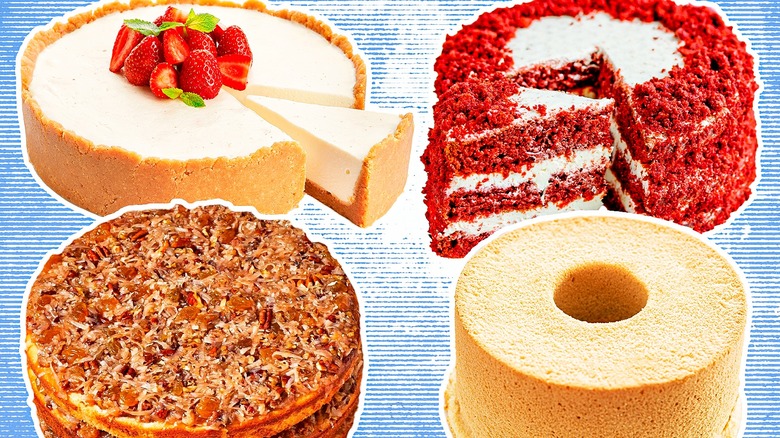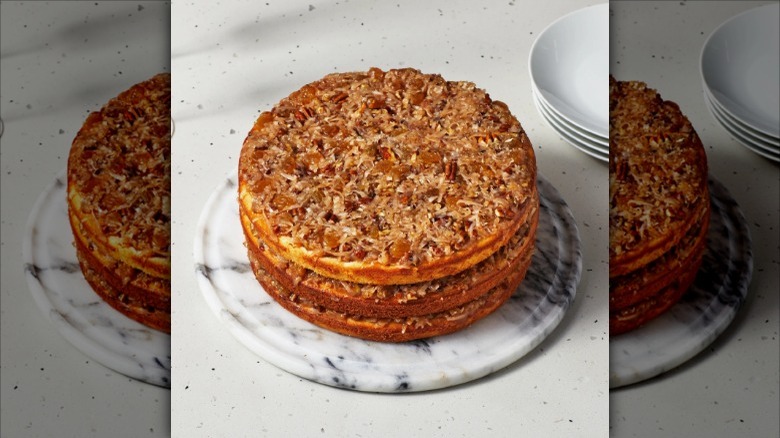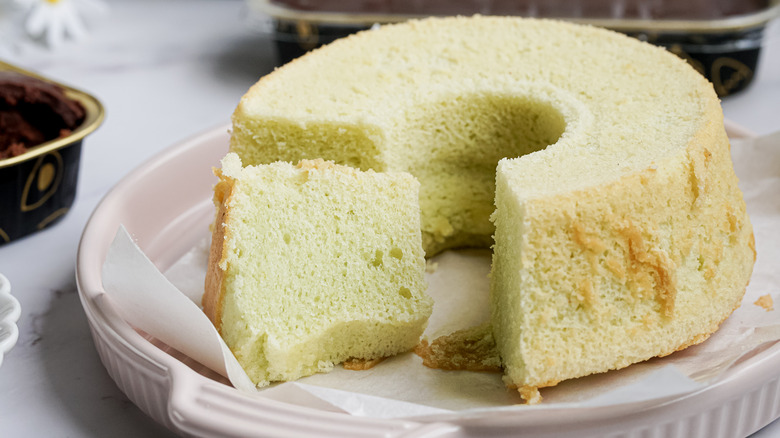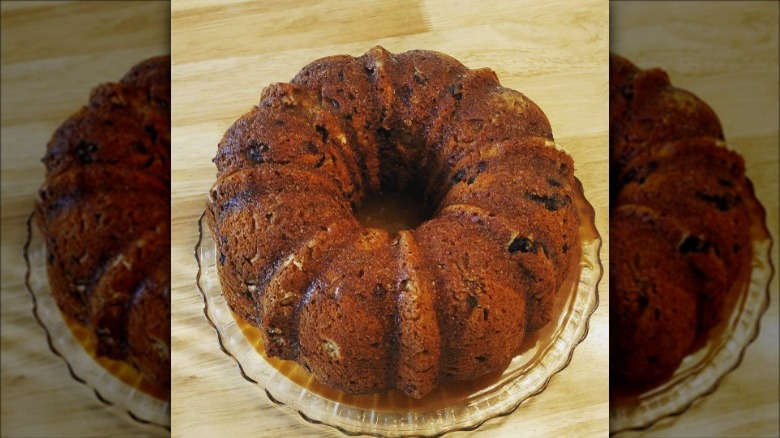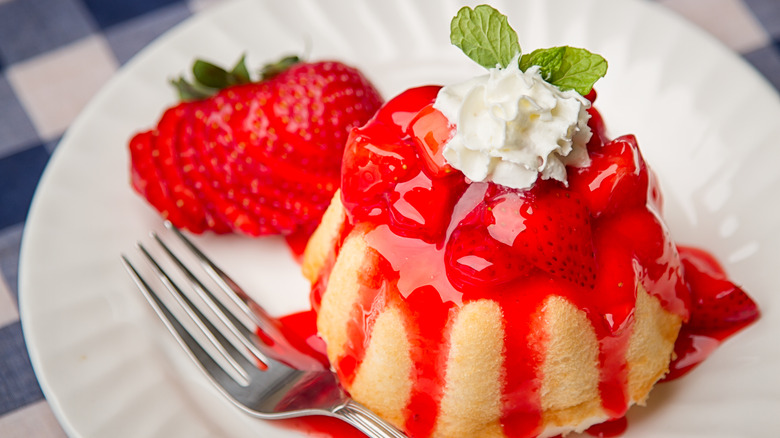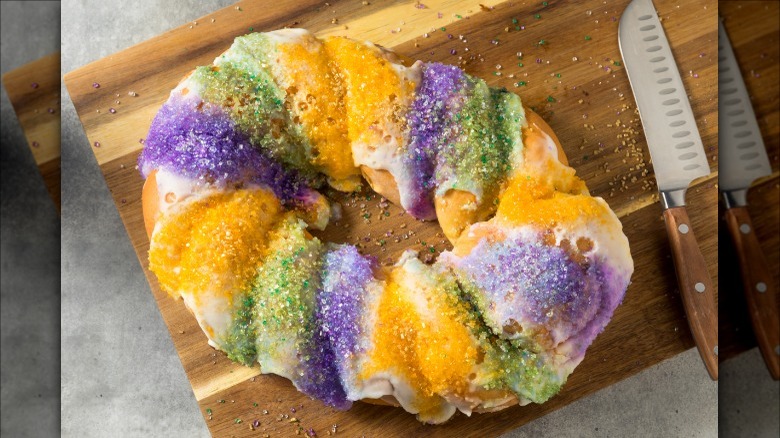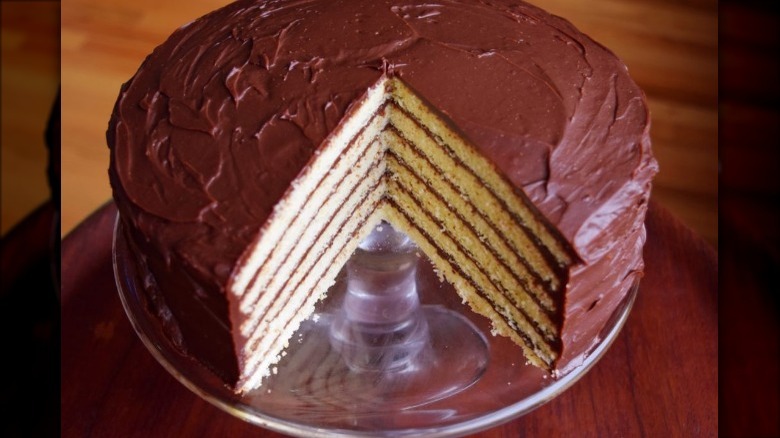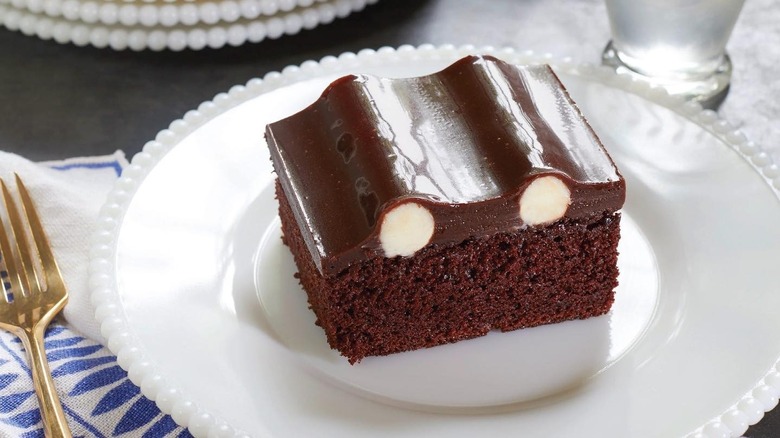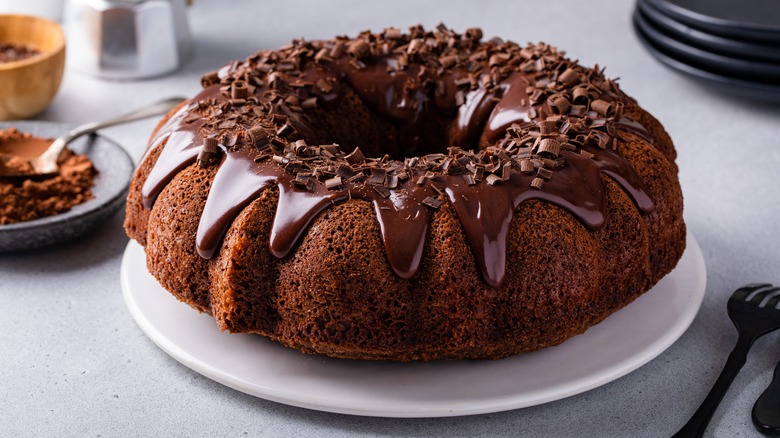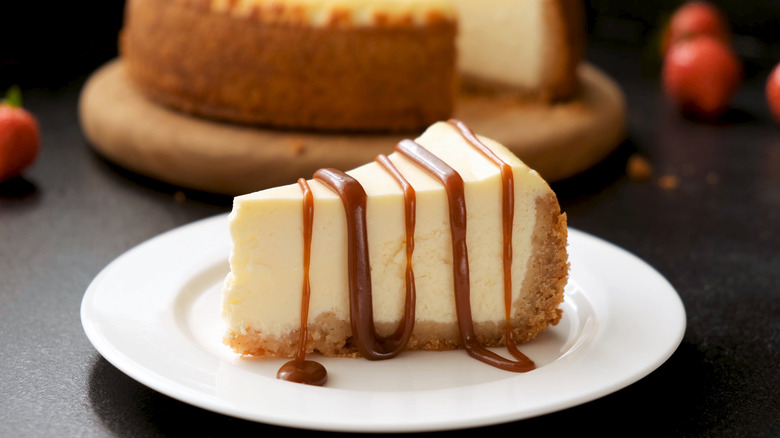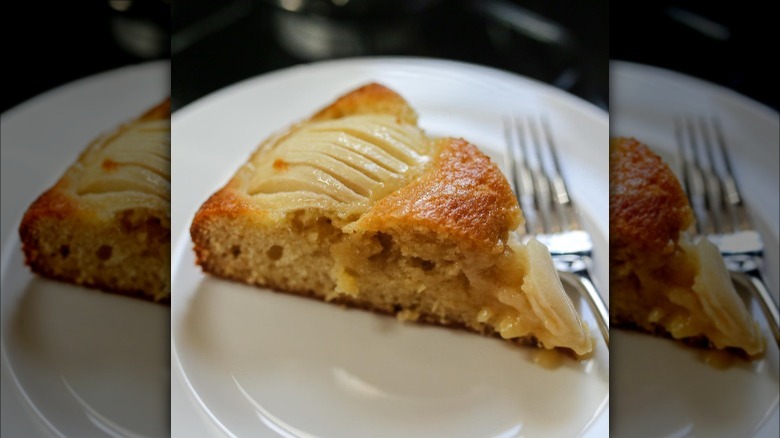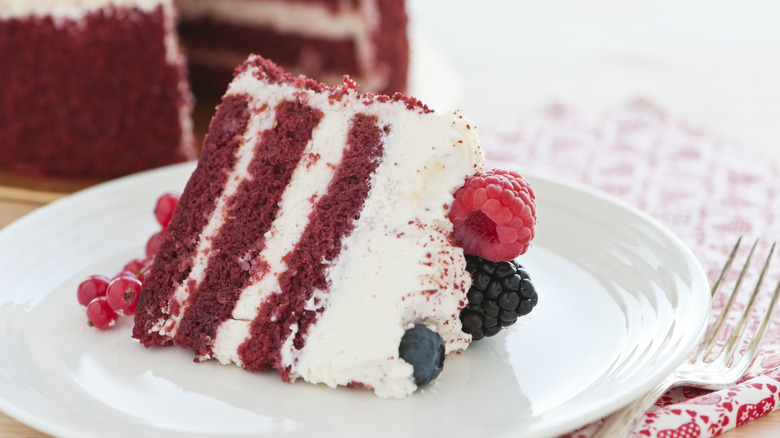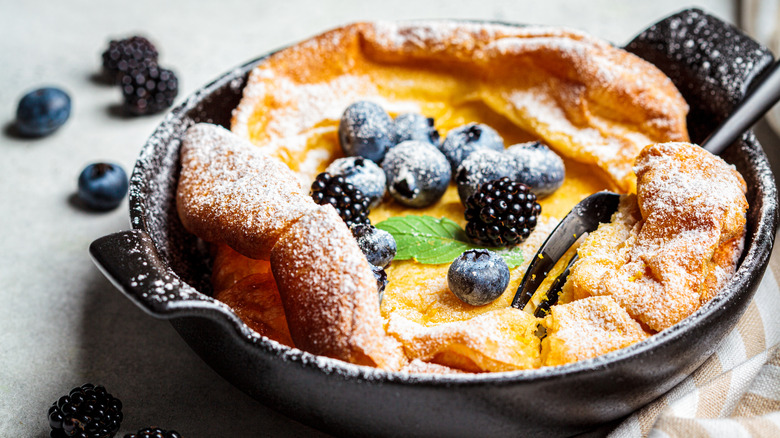The Most Iconic Cakes In 16 States
You've heard of state flags, state flowers, and state fruits, but some U.S. states even have emblematic desserts, and cake is among those iconic desserts of each state. These cakes aren't merely delicious — they also represent cultural and historical aspects of the regions where they originate or are held in high esteem. Not every state in America has an official cake, while some have been a staple for several years. Can you even think of cheesecake without thinking of New York?
Whether they have been legislated as a symbol of the state or are just enjoyed by the locals in fervor, some cakes exemplify a state's heritage and embody the citizens' pride. Be it the Red Velvet Cake of the South or the Boston Cream Pie of Massachusetts, these iconic treats serve a taste of American history. Here, we'll explore some of the most famous and beloved cakes from different states across the U.S.
1. Alabama: Lane cake
Although Alabama Lane cake didn't originate in Alabama, in 2016, the state named it as its official dessert. In fact, it all began at a Georgia County Fair in 1898, where an Alabama native, Emma Lane, presented her original recipe for Lane cake and won first place. As the dessert became increasingly popular in the South, different versions came about, but Lane's traditional recipe calls for layers of sponge cake with a unique filling of chopped raisins that have been soaked in brandy or bourbon whiskey with a spoon of vanilla extract.
With all the varying takes on Emma Lane's "Prize Cake," the dessert soon became a favorite at holidays, especially Christmas. By 1960, it was memorialized in Harper Lee's award-winning novel, "To Kill A Mockingbird," when the Alabamian author wrote of "a Lane cake so loaded with shinny it made me tight" and included the cake as another layer in her depiction of the South (via PBS). Now, its popularity in the South and particularly Alabama has landed Emma Lane's cake as the most famous the state has to offer.
2. California: Chiffon cake
Invented in 1927 by a Los Angeles resident, Harry Baker, Chiffon cake is named for its light, airy texture as a nod to the flowing, soft fabric. The original cake recipe was a delicious blend of both light sponge cake and dense butter cake. The ingredient that made it so sought after? Vegetable oil instead of shortening; you know, the ingredient many of the best store-bought cake mixes use now.
After creating the dessert, Baker kept the recipe under lock and key for decades. Instead, he prepared the cake for the Hollywood elite who dined at the infamous Brown Derby restaurant until he ended up selling the recipe to General Mills (parent of Betty Crocker) in 1947. When General Mills presented the secret recipe in a 1948 issue of Better Homes and Gardens magazine, the cake gained national attention, leading to Chiffon cake contests in the 1950s.
3. Connecticut: Election Cake
Somewhat similar to fruitcake, Election Cake was a big part of election celebrations in 18th- and 19th-century America. In those early days of a new democracy, voters came to Hartford, Connecticut, to cast their votes. Election Cake, which is a bread-like cake filled with nuts and fruits, dates back to Connecticut in 1771, but didn't get a lot of attention until the city of Hartford started having grand parades and balls.
One of the first foods that had political prominence, Election Cake became a tradition in Hartford on Election Day. It also provided women a way to show their patriotism and be involved in politics in a way they weren't before. It wasn't women's suffrage, but women had more of a political voice when baking Election Cakes.
Today, this treat is considered a forgotten recipe of an earlier time, but it is trending again in the digital world. Connecticut's Old State House in Hartford even hosted an Election Cake bake-off competition in 2022.
4. Florida: Strawberry Shortcake
Don't worry, key lime pie, your spot as the Sunshine State's official dessert is safe. Strawberry shortcake, however, was registered as Florida's state cake in a bill that took effect in July 2022. We kid you not when we say CBS Miami reported Sen. Danny Burgess of Plant City, the hub for Florida's prolific strawberry industry, said his bill was a "berry important piece of legislation." Moreover, another Plant City local, Rep. Lawrence McClure, said the bill wasn't designed "to take the key limelight away from the state pie." (Yes, this was a serious debate.)
Even if you know and love the dessert, strawberry shortcake has evolved over the years. Before reaching America, both strawberries and cream, as well as shortcakes, originated from Europe. Native Americans were also known to combine strawberries with a cornbread mix to make a fruity, bread-like cake. But the one we bake today is what has gone down in history as a favorite dessert not only of Europe, America, and the South but of Florida too.
5. Louisiana: King Cake
Stemming from the old world, King Cake is now rooted in Louisiana and Mardi Gras tradition. Every year between January and Ash Wednesday — the day after Fat Tuesday (Mardi Gras) celebrations — King Cake is made and sold in New Orleans. Its colorful trio of green, yellow, and purple twists is symbolic of the three gifts brought by the wise men to baby Jesus in the Biblical story.
Louisiana-style King Cake is a cross between a coffee cake and a cinnamon roll that is filled with fruit and cream cheese — with a tiny baby hidden inside. According to New Orleans' tradition, whoever finds the plastic baby figurine while celebrating Mardi Gras has two choices: supply the next king cake or host a party.
The old-world origins of King Cake began in France and gained popularity during Medieval times. Although it's associated with Mardi Gras parties today, the French were the first to adopt the concept with their galette des rois. But the dessert was also served in celebration of the wise men visiting baby Jesus on the Twelfth Night. Galette des rois isn't colorfully decorated like New Orleans' Mardi Gras-themed cake; rather, it is a beautifully-designed puff pastry with an almond frangipane filling and — that's right! — a hidden bean instead of a baby. Much like Louisiana's newer tradition, finding the bean meant you were expected to throw the next party, but it also meant you could act as "king for a day."
6. Maine: Whoopie Pie
Yes, Whoopie Pie is a snack cake, but it's so beloved that it was designated as Maine's official state treat back in 2011. While the state staked its claim on the confection, some say it originated elsewhere. Whoopie Pies might have started in Amish kitchens in Pennsylvania; at Berwick Cake Co. in Boston during the early 1930s; or in Labadie's bakery in Maine around 1925. Despite the true origins being hazy, Whoopie Pies are certainly a staple snack in the New England area.
A traditional Whoopie Pie consists of a sweet, white, cream filling sandwiched between two cake-like, chocolate rounds. Several Little Debbie snack cakes, like the brand's creme pies, are reminiscent of the original, but nothing compares to the real deal. So whether you try a store-bought version or make Whoopie Pies at home, this confection is a regional delight.
7. Maryland: Smith Island Cake
Since the 1800s, Smith Island Cakes were made on their namesake, Smith Island, Maryland. It came as no surprise when the state claimed the cake as its official state dessert in 2008. The cake was once considered a parting gift that women would make for their husbands as they set off for the autumn oyster harvest. Once a symbol of togetherness, Smith Island Cake has remained emblematic of Maryland culture.
Known for its many layers, the traditional dessert alternates between 8 to 10 very thin layers of yellow cake and frosting, usually chocolate. It is then iced entirely with chocolate or white cream frosting. Here and there, flavors vary but the overall look is always meant to be the same. A few different theories suggest the thin layers were meant to last longer and not dry out during travel or that thinner layers took less time to bake in the wooden ovens used centuries ago. Nevertheless, the cake is a delicious balance of simple flavors and detailed composition.
8. Massachusetts: Boston Cream Pie
This classic pie is actually a cake, and we couldn't be bothered either way — we just want a piece! As the mysterious origins of Boston cream pie allude, the dessert was likely just cooked in pie tins because they were more accessible in the mid-19th century and often used for baking cakes.
Boston Cream Pie was conjured in downtown Boston, where it was served at the 1856 grand opening of Boston's Parker House. It was there that a French chef, Sanzian, created the dessert, then named "Chocolate Cream Pie." With time, the dessert became known as Boston Cream Pie and gained even more momentum by 1958, when Betty Crocker released it as a boxed cake mix.
In 1996, Massachusetts declared Boston Cream Pie as the state dessert. What makes it such a delicacy is not the velvety pastry cream filling, but the decadent chocolate. Back when it was first prepared, chocolate was usually served as a beverage or a pudding; to have it covering a rich cake was another level of indulgence.
9. Michigan: Bumpy Cake
If you ask a Michigander about Bumpy Cake, they'll probably know exactly what you're referencing — after all, it did originate in Detroit. For those outside of Michigan, this cake may be more of a mystery. It starts with Fred Sanders in 1875 when he first opened his Sanders chocolate and candy shop. In a shop full of sweets, Bumpy Cake came about as an accident.
As the story goes, in 1913, Sanders was making one of his classic Devil's Food buttercream cakes when he ran out of frosting. He ended up piping strips of buttercream onto the sheet cake and covered it in chocolate ganache. The end result was a cake with bumps, but his patrons loved it so much that he later coined the name Bumpy Cake for his accidental masterpiece. Today, Bumpy Cake is still for sale at the Sanders candy shop and can even be purchased online for those who want a taste of Michigan without making the trip.
10. Minnesota: Bundt Cake
Although the origins of Bundt Cake are a blend of a European dessert and an American invention, they have long been associated with Minnesota. The Bundt Cake pan was created in 1950 by a Minnesotan family, Dave and Dotty Dalquist, the owners of Nordic Ware, a company known for producing Scandinavian bakeware. When three Jewish women from the Hadassah Society of Minnesota approached Nordic Ware with a specific request — a newly crafted, aluminum rendition of the German kugelhopf pan — Dave Dalquist accepted the challenge and coined the name Bundt.
But the prominence of the Bundt Cake had a major transition around 1966, when a Texan woman, Ella Helfrich, won second place at a Pillsbury Bake-Off for her Tunnel of Fudge cake, which was cooked in a Bundt pan. Pillsbury received over 200,000 letters asking where to find and buy the pan used for the fudgy cake. The popularity of Bundt Cakes skyrocketed over the years to come and is still being baked in kitchens today, thanks to Dot Dalquist's deal with Pillsbury to sell a Bundt cake mix. Yet even though Helfrich is often credited with bringing attention to Bundt cakes, it all started with a Minnesotan husband and wife.
11. Missouri/Kentucky: Butter Cakes
The origins of regional butter cakes are murky, but two things are for certain: Ooey Gooey Butter Cake is undeniably a favorite in St. Louis, and Kentucky Butter Cake is favored in its state. Despite often being linked together, the two desserts are rather different — Kentucky butter cake is more like a pound cake, and Ooey Gooey Butter Cake is more like a brownie and, well ... gooey. They tend to go hand in hand, as they are both moist, buttery cakes that are delicious on their own, without the need for icing or filling although sometimes they'll be dusted with powdered sugar.
Ooey Gooey Butter Cake was created in Missouri; in fact, several St. Louis families claim the original recipe comes from their kitchen. Wherever it truly started, it's clear St. Louis plans to keep it as theirs. Kentucky Butter Cake, however, has a fairly clear starting point. In 1963, Nell Lewis presented her recipe for what would become Kentucky Butter Cake in a Pillsbury Bake-Off — in Platte City, Missouri. So it seems that any way you look at it, butter cake is an iconic dessert in both Missouri and Kentucky.
12. Nevada: Gâteau Basque
In Nevada, Basque culture is taken seriously, with a national Basque Festival hosted every year. It seems fitting that Gâteau Basque (or Basque cake) is so beloved in the state. This sweet treat hails from the Basque region, which straddles both France and Spain; naturally, the cultures are entwined. More like a tart, Gâteau Basque consists of a flaky pastry crust surrounding a creamy, patisserie filling. The pastry dough rises and gives the cake a texture that isn't dense or heavy. Imagine a sweet version of a pot pie, with the cream filling sandwiched inside the crust.
A true staple of Basque cuisine, this cake became popular in Nevada when Basques emigrated to the state in the 19th century. They set up roots in northern Nevada's mountainous terrain and left their mark on the community with a heritage that blends French and Spanish cultures. Although it can be found locally around the state, Gâteau Basque is typically served during the Basque Festival and around holidays.
13. New York: Cheesecake
At this point, New York Cheesecake feels more classic than simply cheesecake. Though many associate the dessert primarily with NYC, the first recorded instance of cheese baked into cakes dates all the way back to Greece in the first century. There, they used to combine broken-up cheese with flour and an egg and molded the mixture into a loaf shape; the "cheesecake" was then cooked in a fire below a brick.
Now, cheesecake is known for having a crumbly, graham cracker crust supporting a rich, sweetened, cream cheese mixture. This version came about in 1872, when a dairy farmer from New York accidentally messed up the French cheese, Neufchatel, and turned it into cream cheese. From there, New Yorker Arnold Reuben is often credited with the invention of New York Cheesecake, but as it was already a roaring success by the 1900s, several New Yorkers attempted to lay claim to the original recipe. Internationally, there are multiple versions of this popular dessert, but in New York, cheesecake is an emblematic staple.
14. South Dakota: Kuchen
German cake, or Kuchen ("ku-gen"), is enjoyed across the Midwest, but South Dakota named it the state's official dessert in 2000. When German settlers came to the Great Plains in their effort to take back their independence in the Homestead Act of 1862, they brought along baking customs. It was then that Kuchen was born in the U.S. and became a dessert widely eaten across the Midwest region. Today, you can even order it online or find it at local retailers.
In the Dakotas, Kuchen typically comes in two ways. The traditional cake is made of sweet dough and has a custard filling with a fruit topping or a type of apple pie filling — this is what South Dakotans call a Prairie-style Kuchen. The other version is called Wedding kuchen, and lacks the fruit; it has a crunchier crust and was often served at, unsurprisingly, weddings.
15. Texas: Red Velvet Cake
Rooted in Southern culture and cuisine, Red Velvet Cake actually hails from the Victorian era, when the term "velvet cake" was used to describe a denser, more refined sponge cake. The reason Red Velvet Cake is red is because of the dark cocoa used — when mixed with buttermilk, the cake turns a reddish color. It wasn't until a Texan man, John Adams, created red food dye for the cake that the complicated red color became easy to achieve.
But he isn't the only reason Red Velvet Cake is now an integral part of Texas and Black American culture. It has gained even more cultural significance in Texas as part of Juneteenth celebrations. Traditionally, red food items are served every year as a symbol of strength, Black liberation, and suffering. Adrian Miller, the James Beard award-winning author, food writer, and historian, discusses how red foods and drinks have long been a marker of Juneteenth celebrations, and red velvet cake is no exception. When looking at old recipes, he even found a version of a Red Velvet Cake, instead called Red Devil's Food Cake.
16. Washington: Dutch Baby Pancake
We're counting Seattle's infamous Dutch Baby Pancake as a cake since it definitely borders on dessert, and isn't what we've come to know of as pancakes or crepes; the fluffy Japanese pancake is perhaps closest in comparison. Somewhat of a cross-over between a soufflé and a popover, the Dutch Baby's ancestor is the German pancake, pfannkuchen. Still, Dutch Babies are a unique sweet, and sometimes savory, treat that is renowned in Seattle, thanks to their appearance at Manca's Café in the 1940s. Ironic in name, Dutch Babies are actually large enough to split.
Unlike most pancakes, which are fried and flipped on a stovetop, the batter for a Dutch Baby is baked in an iron skillet and when removed from the oven, the large pancake instantly deflates (to leave room for more toppings!) while keeping its crispy edges. You can top this treat with anything from sweet ingredients like berries, whipped cream, or jam to savory ingredients like eggs, avocado, smoked salmon, or crème fraîche.
